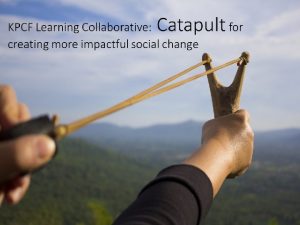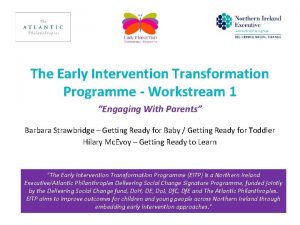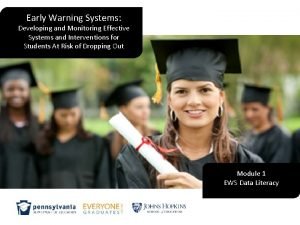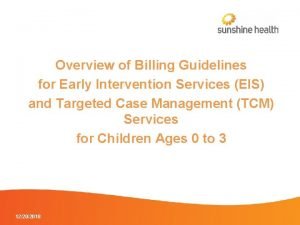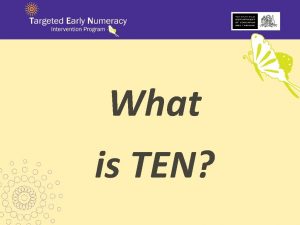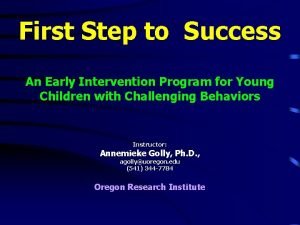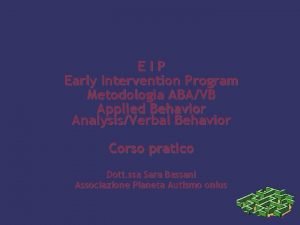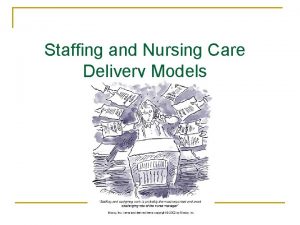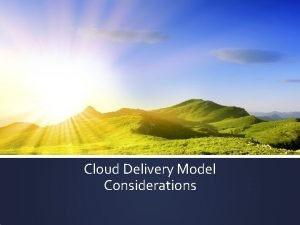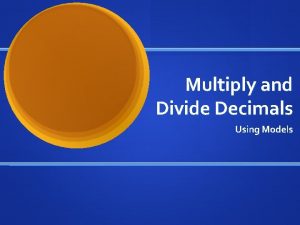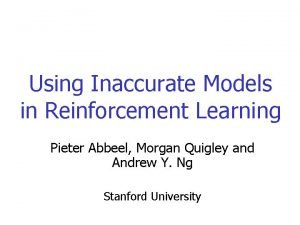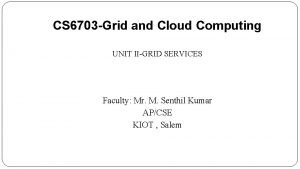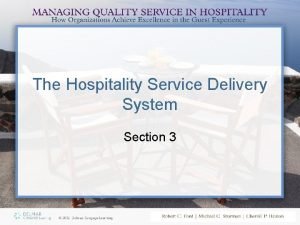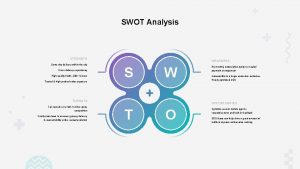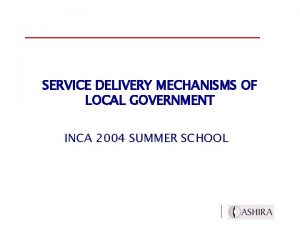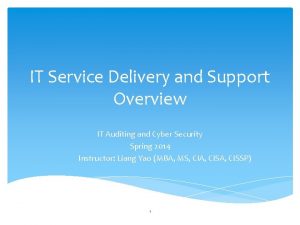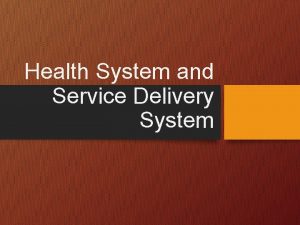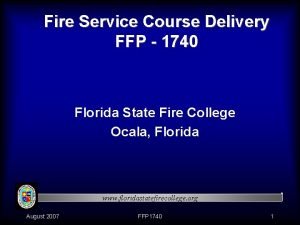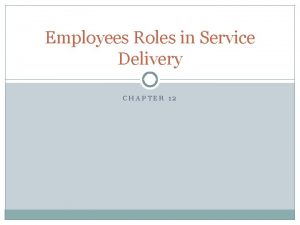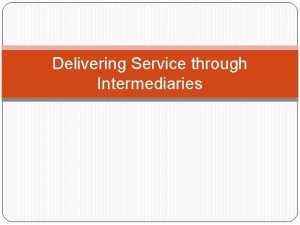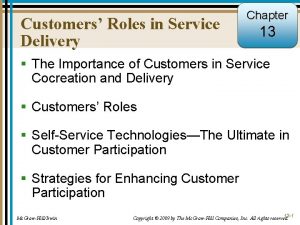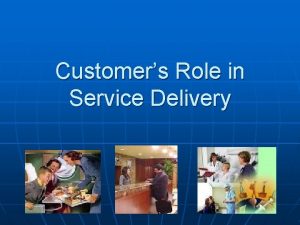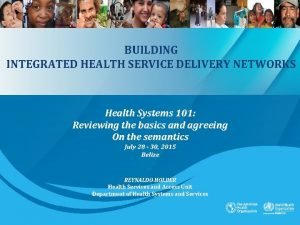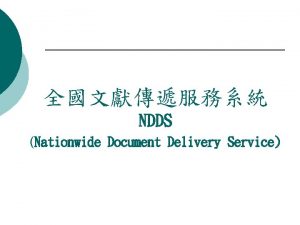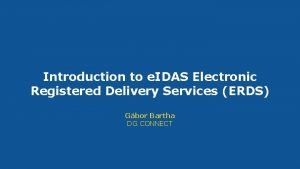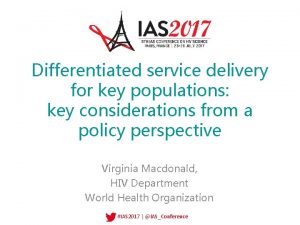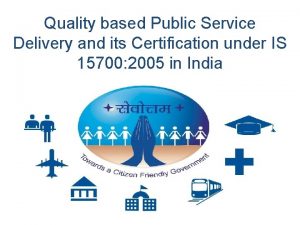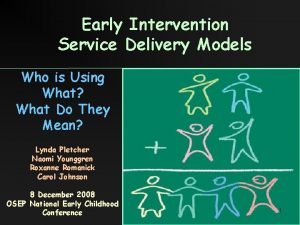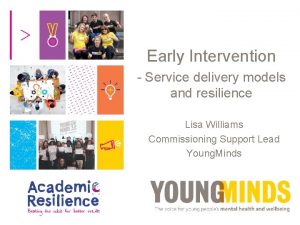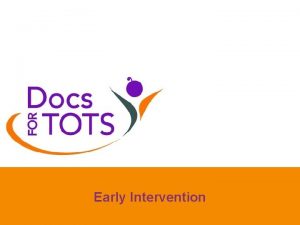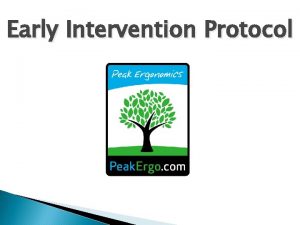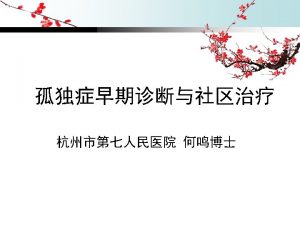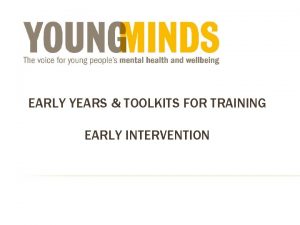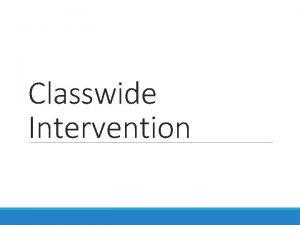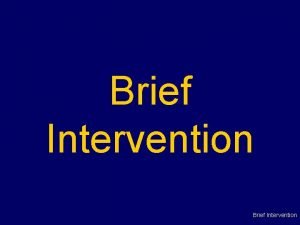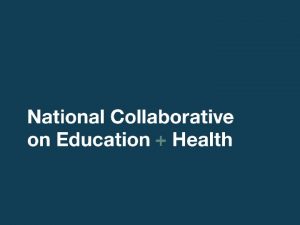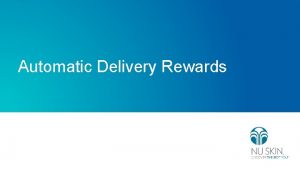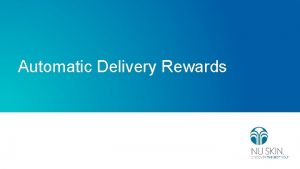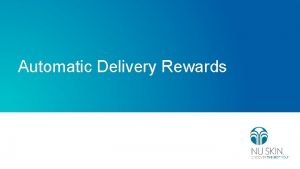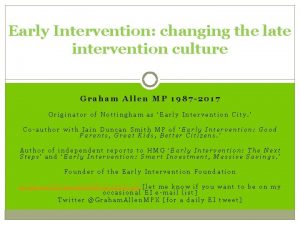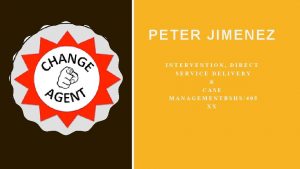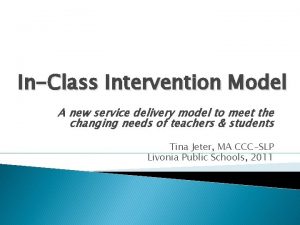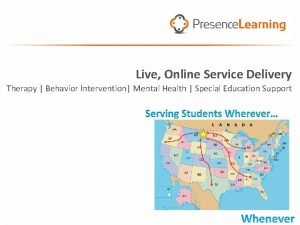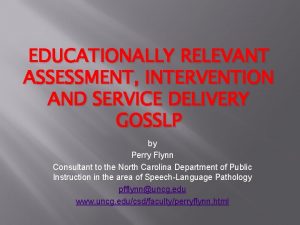Early Intervention Service Delivery Models Who is Using





































- Slides: 37

Early Intervention Service Delivery Models Who is Using What? What Do They Mean? Lynda Pletcher Naomi Younggren Roxanne Romanick Carol Johnson 8 December 2008 OSEP National Early Childhood Conference 1

An Array of Team-Based Service Delivery “Models” A. Multidisciplinary B. Interdisciplinary C. Trans-disciplinary D. Primary Service Provider E. Primary Coach F. Consultation Services G. Collaborative Team Model H. Trans-agency Participant Poll: Which of the words best describes what your program/state is using? 2

The Meaning Behind the Terms q Trans-disciplinary Evolved from MD to ID to TD. Professionals share roles & see the child as a whole in the context of the family. q Primary Service Provider Linked to a Trans-disciplinary model. PSP works in close collaboration with other team members integrating & synthesizing information shared to deliver efficient & comprehensive support. Service delivery by one person with supporting services provided through joint visits & consultation. 3

The Meaning Behind the Terms Coaching – “…an interactive process of observation and reflection in which the coach promotes a parent’s or other care provider’s ability to support a child’s participation in everyday experiences and interactions with family members and peers across settings” Rush, D. D. , Shelden, M. L. , & Hanft, B. E. (2003) Foundations in principles of adult learning q Primary Coach Approach to teaming “…assigns one member of a team as the primary coach, where he or she receives coaching from other team members, and uses coaching with parents and other primary caregivers to support and strengthen their confidence and competence in promoting child learning and development. ” Shelden & Rush http: //www. coachinginearlychildhood. org/pcateamingintro. php 4

The Meaning Behind the Terms q Consultation services Not tied to one particular model, but flexible to meet the individual needs of children and families and variation in program structure. Oregon Work Group Sep. 24, 2001 q Collaborative team model Team members work in partnership and pool resources. All team members are involved in planning and monitoring goals and procedures, although each team member’s responsibility for the implementation of procedures may vary. Team members jointly share ownership & responsibility for intervention objectives. 5

The Meaning Behind the Terms q Trans-agency Provides a process for the primary service provider, the family, and staff from outside agencies serving the family, to come together to develop an across agency service plan for the child and the family. Massachusetts http: //www. nectac. org/~pdfs/calls/2004/partcsettings/324 call/Presenting. TDModelto. Family. pdf 6

The Common Theme… on & Co ati c i n u mm 7

What Organizations Say… q q q ASHA AOTA APTA DEC National Workgroup on Principles & Practices of Services in Natural Environments COP “Model” Neutral “Key principle #6: “The family’s priorities needs and interests are addressed most appropriately by a primary provider who represents and receives team and community support. ” 8

The Bigger Picture q One provider cannot meet the multifaceted needs of families of children with disabilities. q Providers cannot wear blinders that limit them to seeing only one specific domain. q Families and children represent complex systems with numerous intertwined strengths, resources, needs, hopes, dreams, and desires. q Perhaps greater emphasis is needed on employing familycentered practices rather than achieving one specific teambased service delivery model. Lamorey and Ryan (1998) 9

The Challenges q Early intervention legislation dating back to 1986 reinforced system design, as well as cross-disciplinary team involvement and recognition that parents are essential decision-makers. Yet, early intervention programs persist with the struggle to establish collaborative teamwork across disciplinary boundaries. q Systems do not struggle because of lack of individual skill but “because they are unable to pull their diverse functions and talents into a productive whole” (Senge, 1973 p. 69). q Working within the climate of budget constraints. 10

It Is Not Simple q The diversity among program design coupled with a mix of professionals coming together on an early intervention team contributes to the challenges of providing holistic family-centered early intervention services in natural environments. q Adapting versus adopting practices and constructs from various models to uniquely fit complex systems. q A potpourri of system designs. Spiker, Hebbler, Wagner, Camelto, & Mc. Denna (2000) 11

State Models q Part C Coordinators Email Survey June ‘ 08 43 states responded 9…. . Primary Service Provider model 6…. . Trans-disciplinary Team Model with "consultation” 5…. . Routine Based Interventions 2…. . Primary Coach Approach 5…. . Developing a Primary Service Provider Model 6…. . Combination of the above 10…. No named model or specific type of intervention methods 12

State Models q A closer look at two state journeys Do. D - Army EDIS Educational & Developmental Intervention Services North Dakota 13

Who We Are ARMY Ft. Bragg, NC Ft. Knox, KY West Point, NY Ft. Benning, GA Ft. Campbell, TN Ft. Jackson, SC Ft. Rucker, AL Ft. Stewart, GA Ft. Buchanan, PR NAVY Beaufort, SC Portsmough, VA Quantico, VA Camp Lejeune, NC Guam AIR FORCE Maxwell AFB, AL Robins AFB, GA q OVERSEAS Army, Navy, AF Germany Italy Belgium Netherlands Spain UK Turkey Korea Japan 14

EDIS (Army) CONUS Ft. Bragg, NC Ft. Knox, KY West Point, NY Ft. Benning, GA Ft. Campbell, TN Ft. Jackson, SC Ft. Rucker, AL Ft. Stewart, GA Ft. Buchanan, PR OCONUS Germany Italy Belgium Netherlands Korea 15

EDIS (Army) q Population Served US: Military families residing on military installations with a Do. D school system Overseas: Military and Do. D Civilian families working with the military and living overseas q Eligibility Criteria -2 SD or 25% delay in one area or -1. 5 SD or 20% delay in two + areas q All providers “under one roof” q Time in program: Mean 10. 6 months q EI Population: 439 enrolled as of 1 Oct 2008 715 served FY 2008 16

Why a PSP Model? q. Believed in this best practice model. q. Believed more is not better. q. Recognized the potential for more effective staff utilization. 17

The Journey q Training campaign (initially top down). q Moved from discipline specific training to holistic training. NE emphasis (how not what services provided). TD Handbook with required exams. q Philosophy embedded in “state” implementation regulations. q Reduced designated family service coordinators. q IFSP process with a team-based structure & required RBI. q Brochures about program with PSP focus. q Standard technical interview questions part of hiring process. q Support, technical assistance, local mentoring. q Monitor compliance & extend support. q Educate medical community & referral sources. 18 q Keep abreast of research, policy changes, and practice.

Army EDIS IFSPs with Individual Services Point In Time 1 October Monitoring 19

Implementation …who does what when q Referral/Intake Initial SC • could be anyone on team • contacts family and conducts screening if necessary • follows family through IFSP process and may be an ongoing SC or provider C One person to follow the family through. C Facilitates relationship building. ~ Available provider might not always from the discipline of the family’s primary concern. ~ All providers need training and expertise in SC. 20

Implementation …who does what when q Evaluation/Eligibility Initial SC participates in evaluation C Initial SC may see child more than once before determining eligibility. C Family not needing to retell their story. C Promotes continuity. ~ Scheduling, as all team members function as SCs and providers. ~ All providers need training and expertise in evaluation and eligibility determination. 21

Implementation …who does what when q RBI/IFSP Initial SC participates in RBI & MLPSP may lead RBI C Family not needing to ~ Scheduling, as all team retell or repeat members function as SCs information. and providers. C SC has a picture of family ~ All providers need training concerns from beginning. and expertise RBI and IFSP development. C Relationship further fostered. C Outcomes are functional. 22

Implementation …who does what when q Ongoing Support/Service Delivery Initial SC may become ongoing PSP One individual provider with collaborative visits with consulting/monitoring providers C Family receives coordinated information from primary provider. C Support is available from other providers/agencies. C Focus is put on helping families & intervention between visits. ~ Scheduling time for consultation. ~ Incoming IFSPs with multiple individual services. ~ Educating others why “more” is not better. 23

Lessons Learned "What I need is an exact list of specific unknown problems we might encounter. “ (Lykes Lines Shipping) 24

Lessons Learned q. Keep getting traction q. Listen to those operationalizing the model q. Monitor continuously q. Provide ongoing training (varied approaches) q. Celebrate success 25

26

North Dakota q Population Served: Rural/Frontier q Eligibility Criteria: High risk condition, 50% delay in one developmental area, 25% delay in two or more developmental areas q Provider description: State Department of Human Services contracts with 9 providers across the state (at least one in each human service delivery region). Service Coordination is delivered through a dedicated model with staff employed as state employees in the 8 Human Service Centers across the state. q EI Population: 935 on December 1, 2008 27

The Journey q q q Historic home visiting/developmental model infrastructure. Establishment of a statewide technical assistance system. Establishment of a statewide comprehensive monitoring process. Identification of statewide skill development and training needs. Establishment of statewide mandatory Medicaid participation. More families receiving Early Intervention services and additional supplemental medical services due to additional funding sources. Increasing need to clarify, define, and enhance EI service delivery. Statewide training efforts on routine-based interviewing and assessments, writing and implementing functional outcomes, use of technology to support service delivery, etc. Ongoing ICC committee work on staff competency and service delivery. Involvement of marketing agency to make recommendations on messaging, products, and dissemination. Monthly statewide meetings with EI staff via IVN for education, information, and communication purposes. 28

The Impact q. Targeted overriding infrastructure for monitoring system. q. Strengthened trans-disciplinary model. q. Focus on coaching and adult learning strategies. q. Focus on routines, natural learning opportunities, and functional outcomes. 29

Lessons Learned q. Spend time clarifying what you have. q. Learn how to use both quantitative and qualitative data to make decisions. q. Look systemically. q. Use every opportunity to address change. q. Infuse family voice at every opportunity. 30

Table Talk q. If you asked a family in your state/program to describe how services are provided what would they say? q. Do these family descriptions match your model? If not, why not? q. What materials are developed/being developed to help bridge gaps? 31

Major Types of Change q. Incremental Tuning up something, improving something you already do, adapting something in a different way, altering tasks or methods. q. Re-orientation Creating something new within the existing system, pushes the boundaries of core competencies, second order change-new methods and tasks AND altering relationships and roles. q. Re-creation Big jump out of the realm of what currently exists, second order change, create new systems to support the new ideas, old ways are completely gone. 32

Re-orientation + Re-creation = “hard” change q A clear where are you going and why shared vision. q Complex and complicated. q Requires careful planning at multiple levels & layers. q Takes more time & energy & often fiscal resources. q Requires new tasks, methods, relationships & roles be defined and implemented. q Management of smaller “innovations” but all must be connected to the bigger picture. q Leadership skills are essential! 33

Common Mistakes þ Not knowing what type of change we need. þ Not clear on what we are trying in the big picture to accomplish. q All the incremental change efforts in the world won’t work if the problem really needs re-orientation or recreation to solve it. q Many people avoid the “harder” change and do “anything” just to get “something” done. q Lots of incremental changes may in fact make things worse, solve the wrong problem or uncover many new ones. 34

To Begin & Sustain Change q Remember what change is all about. q Decide on the type of change you need for the innovation are you trying to accomplish, keeping the end in mind. q Plan with a systems orientation. q Lead with systemic skills. q Know your “people” and support their needs. q Keep it going- understand the “phases “ of transforming something. q The change in the end brings about something better for all those involved! 35

Teamwork! 36

Lynda Pletcher Lynda_Pletcher@unc. edu Naomi Younggren Naomi. Younggren 2@us. army. mil Roxanne Romanick romanic@bismidco. net Carol Johnson carojohnson@nd. gov 37
 Human service delivery model
Human service delivery model Early intervention transformation programme
Early intervention transformation programme Early warning intervention and monitoring system
Early warning intervention and monitoring system Po box 3070 farmington mo 63640
Po box 3070 farmington mo 63640 Nuffield early language intervention programme
Nuffield early language intervention programme Targeted early numeracy intervention program
Targeted early numeracy intervention program Omebase
Omebase Abavb
Abavb Modals and semi modals
Modals and semi modals Nursing care delivery models
Nursing care delivery models Team nursing care model
Team nursing care model Cloud delivery model considerations
Cloud delivery model considerations Training plan outline for work immersion sample
Training plan outline for work immersion sample Early cpr and early defibrillation can: *
Early cpr and early defibrillation can: * Accenture delivery
Accenture delivery Mamdm
Mamdm Using recursion in models and decision making sheet 3
Using recursion in models and decision making sheet 3 Modeling multiplication of decimals
Modeling multiplication of decimals Lesson 3 using economic models
Lesson 3 using economic models Problem solving using algebraic models
Problem solving using algebraic models Using inaccurate models in reinforcement learning
Using inaccurate models in reinforcement learning Data intensive grid service models
Data intensive grid service models Service delivery system in hospitality industry
Service delivery system in hospitality industry Delivery service swot analysis
Delivery service swot analysis Internal and external service delivery mechanisms
Internal and external service delivery mechanisms It service delivery and support
It service delivery and support It service delivery objectives
It service delivery objectives Fire service course delivery
Fire service course delivery Role of employees in service delivery
Role of employees in service delivery Effective service delivery
Effective service delivery Role of intermediaries in service delivery
Role of intermediaries in service delivery Service delivery roles
Service delivery roles Customer roles in service delivery
Customer roles in service delivery Integrated delivery network definition
Integrated delivery network definition Ebsco password
Ebsco password Electronic registered delivery service
Electronic registered delivery service Differentiated service delivery
Differentiated service delivery Sevottam model diagram
Sevottam model diagram
